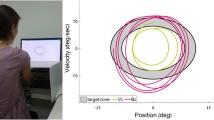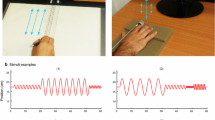Abstract
During forearm tracking of a sinusoidally moving target matching of proprioceptive and visual feedback was altered by introducing different visual delays. In five normal subjects seven target frequencies were tested ranging from 0.3 to 1.5 Hz. For each target frequency nine different delays were used ranging from 0 to 120% of the cycle duration with target frequency and delay being varied randomly. Tracking error revealed a cyclic behaviour with an increase up to delays of about 50% of the target cycle duration and an improvement for delays larger than 50%. Modulation of response frequency was less pronounced compared with tracking error variation but also was dependent on relative phase. The response frequency matched the target frequency at delays of 0 and 100% of cycle duration and was slightly lower than the target frequency with relative delays of about 50%. The introduction of a visual delay during sinusoidal forearm tracking leads to a spatial in addition to the temporal mismatch between proprioception and vision. The temporal and the spatial incompatibility influence the tracking performance differentially.
Similar content being viewed by others
Author information
Authors and Affiliations
Additional information
Received: 20 February 1996 / Accepted: 26 March 1997
Rights and permissions
About this article
Cite this article
Langenberg, U., Hefter, H., Kessler, K. et al. Sinusoidal forearm tracking with delayed visual feedback I. Dependence of the tracking error on the relative delay. Exp Brain Res 118, 161–170 (1998). https://doi.org/10.1007/s002210050268
Issue Date:
DOI: https://doi.org/10.1007/s002210050268




